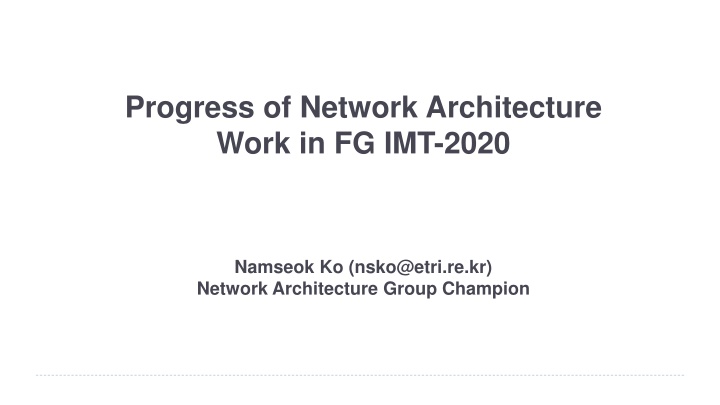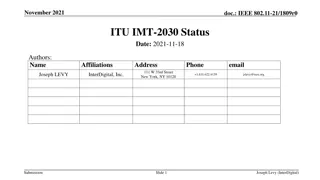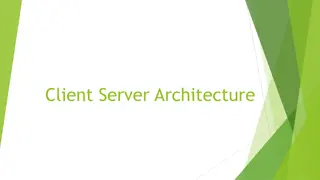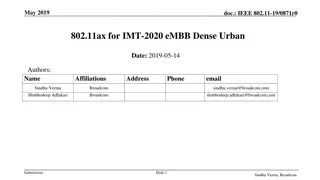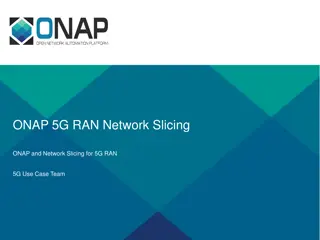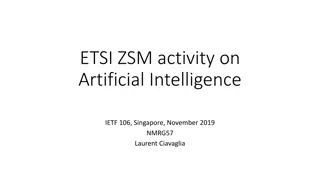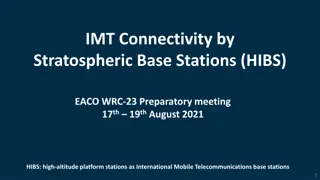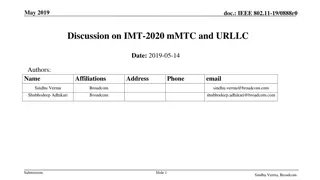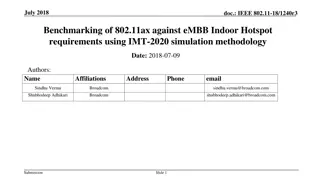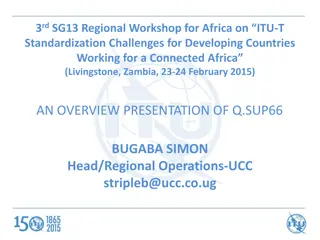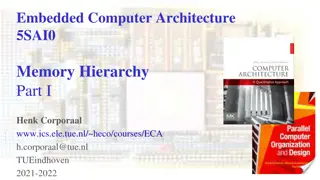Progress of Network Architecture Work in FG IMT-2020
In the Network Architecture Group led by Namseok Ko, significant progress has been made in defining the IMT-2020 architecture. The work has involved gap analysis, draft recommendations, and setting framework and requirements. Phase 1 focused on identifying 19 architectural gaps, such as demands for different bandwidths, application-aware network architecture, and enhancing privacy and security. Phase 2 delved into IMT-2020 requirements from service and network operation perspectives, covering aspects like mobile broadband services, network flexibility, scalability, and security protocols.
Download Presentation

Please find below an Image/Link to download the presentation.
The content on the website is provided AS IS for your information and personal use only. It may not be sold, licensed, or shared on other websites without obtaining consent from the author.If you encounter any issues during the download, it is possible that the publisher has removed the file from their server.
You are allowed to download the files provided on this website for personal or commercial use, subject to the condition that they are used lawfully. All files are the property of their respective owners.
The content on the website is provided AS IS for your information and personal use only. It may not be sold, licensed, or shared on other websites without obtaining consent from the author.
E N D
Presentation Transcript
Progress of Network Architecture Work in FG IMT-2020 Namseok Ko (nsko@etri.re.kr) Network Architecture Group Champion
5W1H of Architecture Work Gap Analysis (phase 1) : 19 gaps in architecture Draft Recommendations (phase 2) : Framework and Requirements W W High-level architecture group with all FG members W San Diego, Torino, Geneva, Beijing, Seoul, Palo Alto W June 2015 ~ December 2016 W To define IMT-2020 architecture from network perspective H 8 face-to-face meetings and multiple conference calls
Phase 1 : Gap Analysis (1/2) 19 architectural gaps Various bandwidth/data-rates demands Complex connectivity model Application-aware and distributed network architecture Signalling complexity in massive MTC Increasing service availability Signalling to reduce end-to-end complexity End-to-end network latency model Mobile network optimized softwarization architecture Data plane programmability
Phase 1 : Gap Analysis (2/2) 19 architectural gaps (cont d) End-to-end QoS framework Energy efficiency Enhancement of privacy and security Enhancement identity management Multi-RAT connectivity Fixed mobile convergence Flexible mobility Mobility management for distributed flat network End-to-end network management in a multi-domain environment OAM protocols
Phase 2 : IMT-2020 Requirements (1/2) Requirements from service points of view Enhanced mobile broadband services Enhanced massive machine type communications Ultra-reliable and low latency communication services Requirements from network operation point of view Network flexibility and programmability Fixed-mobile convergence Enhance mobility management Scalability Network capability exposure Authentication
Phase 2 : IMT-2020 Requirements (2/2) Requirements from network operation point of view (cont d) Flexible signaling Numbering, naming and addressing QoS Control Context awareness Profile management (User, Device, etc.) Network management Accounting and charging Interworking Security
Phase 2 : IMT-2020 Framework (1/3) IMT-2020 slice life-cycle management Applications Management and Orchestration Plane (including slice templates) Service Plane Softwarization is embedded across overall layers by leveraging SDN, NFV, data plane programmability, cloud computing, etc. Control Plane Data Plane Resources Applications Applications Service Plane Service Plane Service Plane M G M T M G M T M G M T Control Plane Control Plane Control Plane Data Plane Data Plane Data Plane Resources Resources Resources Instance #1 Instance #n Instance #2 Slice instances (eMBB, CritC, etc.) Conceptual IMT-2020 non-radio network architecture
Phase 2 : IMT-2020 Framework (2/3) IMT-2020 Architecture Diagrams
Phase 2 : IMT-2020 Framework (3/3) Multiple access technologies (IMT-2020, IMT, WiFi, and fixed networks) with access agnostic common core network Separation of control plane (CP) and user plane (UP) functions, allowing independent scalability and evolution Distributed flat network allowing flexible deployment of CP/UP functions Converged data plane functions (IP flow management, Multi-RAT coordination, etc.) Unified control functions (e.g. authentication) at the core with some functions at the edge Modular function design to enable flexible network (e.g. separation of MM and SM) Architecture to support diverse service requirements Different mobility and diverse end-to-end QoS (data rate, reliability, latency etc.) requirements Softwarization everywhere leveraging existing tools such as SDN and NFV End-to-end network slicing to provide dedicated logical networks with customer (or service) specific functionality; network capability exposure Edge cloud support (MEC), distributed content and services
Next Step! Question # A/13 B/13 C/13 D/13 E/13 F/13 G/13 H/13 I/13 J/13 K/13 L/13 M/13 Question title IMT-2020: Network requirements & functional architecture NGN evolution with innovative technologies including SDN and NFV Software-defined networking, network slicing and orchestration QoS aspects including IMT-2020 networks Upcoming network technologies for IMT-2020 & Future Networks Fixed-Mobile Convergence including IMT-2020 Knowledge-centric trustworthy networking and services Innovative services scenarios, deployment models and migration issues based on Future Networks Applying networks of future and innovation in developing countries Big data driven networking (bDDN) and Deep packet inspection (DPI) Requirements, ecosystem, and general capabilities for cloud computing and big data Functional architecture for cloud computing and big data End-to-end Cloud computing management and security WP: IMT-2020 Networks & Systems
